Takoma's Brookland moment: some opposition to apartment development on the WMATA station site
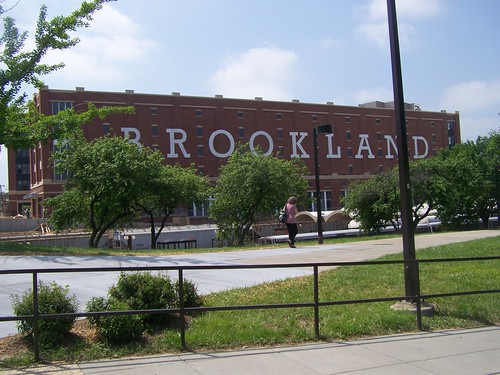 DC's Brookland neighborhood has been roiled by 21st century plans and acts to leverage proximity to the subway station there, by adding denser development to a few blocks at and around the Metro. This will happen with three parcels:
DC's Brookland neighborhood has been roiled by 21st century plans and acts to leverage proximity to the subway station there, by adding denser development to a few blocks at and around the Metro. This will happen with three parcels:(1) 3.5 blocks owned by Catholic University, being redeveloped into the Monroe and Market mixed use development with about 900 apartments (one of the buildings is pictured at right);
(2) eventual sale and redevelopment of undeveloped land on the WMATA station site; and
(3) the redevelopment into apartments of the Colonel Brooks Tavern site and associated adjacent properties. The first and third projects abut residential property. The first only a handful of houses on Lawrence Street, the third projects 20-30 houses maybe, on 10th Street and Lawrence Street.
There has been a lot of angst about these projects.
There are a couple of reasonable points in the discussion, first the support within the community to preserve one of the blocks of the WMATA site as a green space, as it serves as part of the front yard/grounds of the historic Brooks Mansion, and residents on 10th Street NE have been angry about how the back side of their block will be redeveloped as a taller apartment building, when the block has been comprised of two story attached and detached single family houses, plus the old restaurant building (since demolished).
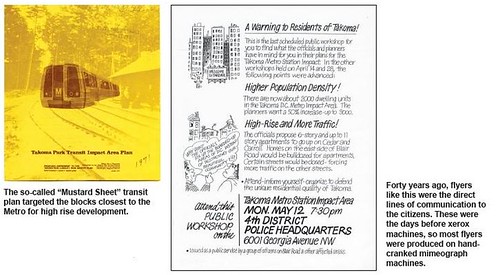
Brookland and Takoma share a similar narrative about their respective community histories and their sense of themselves as a community. Each was developed as an in-city suburb, leveraging access to passenger railroad service from the B&O.
Brookland started being developed in the late 1880s, starting with a sale of a parcel to the Catholic Church, land for the creation of Catholic University. CUA in turn attracted other religious institutions, which centered the neighborhood, along with various residential developments and a small commercial district, first around teh railroad station and then on 12th Street.
Takoma was created in the 1890s, with the purchase of land spanning the DC and Maryland borders. Later Takoma too developed around religion, as the Adventist Church chose the community for its eastern headquarters. The Adventists started a college, hospital, and seminary, and had their publishing arm based in the city for many decades. (These days the Adventist presence amongst residents is significantly less pronounced, although some Adventist elementary schools and other institutions remain.)
Residents from both neighborhoods were key to the successful battle against freeways in DC and suburban Maryland. (Takoma's Sammie Abbott went on to become mayor of Takoma Park.)
I-70, now I-270, was supposed to continue from its current terminus at the Beltway to Union Station, and various other freeways were planned to serve the city and Montgomery and Prince George's Counties. (This 1966 Shell map shows the proposed routes as of that time; which by then, already the I-70 extension had been taken off the table. Also see the FHWA webpage on Interstate freeway "withdrawals".)
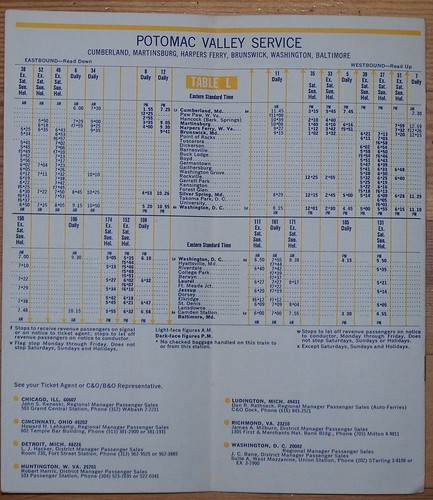 Railroad passenger service served the communities until the start of the Metro service. The 1969 railroad timetable pictured on the right shows service to the Takoma and University (Brookland) stations.
Railroad passenger service served the communities until the start of the Metro service. The 1969 railroad timetable pictured on the right shows service to the Takoma and University (Brookland) stations. As plans for the system developed, Takoma subsequently fought off urban renewal like plans for development around the station, while the Brookland station site didn't have such plans.
Both neighborhoods laid fallow development-wise until the late 1990s, as new development was more focused on the core of the city.
But as more of the core was built out (helped along by the entry of the Verizon Center to then termed "East End"), real estate developers began looking outward to other locations in the city, especially adjacent to transit stations, and both communities experienced proposals for new development at the stations.
Both neighborhoods successfully fought off what would have been inappropriate development at the Metro--but inappropriate because it didn't adequate leverage transit proximity and was under-dense, not because it was development but that is not the lesson people took from their "success", and so they have a sense about themselves that they can fight off any development.
When really, what they were successful at was fighting off bad development. Fighting off "good" development isn't so easy.
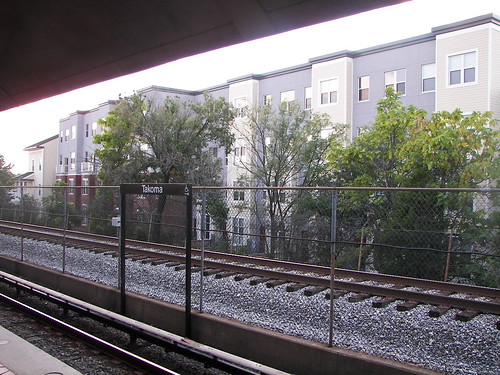 Right: the rear of the Cedar Crossing Condominiums abut Spring Place NW, on the west side of the railroad tracks on the Blair Road side of the Takoma DC neighborhood.
Right: the rear of the Cedar Crossing Condominiums abut Spring Place NW, on the west side of the railroad tracks on the Blair Road side of the Takoma DC neighborhood.In Takoma, in the past few years three apartment or condo developments have been built abutting the Metro station. Another development is under construction--a Busboys and Poets will be locating there (see "Busboys and Poets coming to Takoma, and may head to Brookland" from the Washington Post), another on Spring Place is working through the approval process, and another development is in the pipeline.
With a couple of exceptions these developments will absorb most of the build out capacity of the neighborhood, and going forward beyond these developments there will be limited impact on the extant residential sections of the neighborhood. (The Walter Reed campus abuts part of Takoma and will be redeveloped over the next 20 years. But this won't impact Takoma per se all that much, other than providing access to additional retail.)
The primary reason I favor denser development at Metro stations is that it allows, for the most part, preservation of the bulk of a neighborhood's residential character with minimal changes. This is true for both Brookland and Takoma--although the community's unwillingness to make some hard choices in Brookland likely means that Brookland's traditional retail core, currently strung along 12th Street, will re-center to Monroe Street by the transit station (functioning similarly to the Shoppes at ArtDistrict development in Hyattsville that I wrote about earlier).
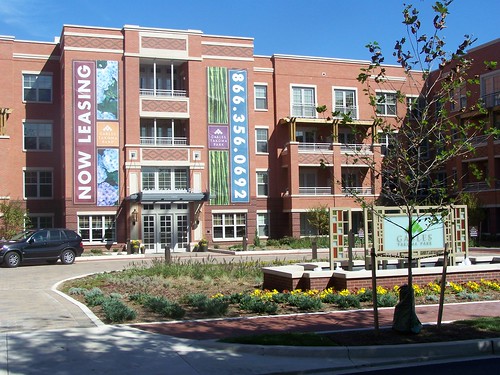 Left: the Gables Apartments on Blair Road were intended to be sold as condominiums, which is why the building has particularly attractive facades.
Left: the Gables Apartments on Blair Road were intended to be sold as condominiums, which is why the building has particularly attractive facades.In 2007, WMATA made an agreement with local developer EYA, a company well-known for their focus on building townhouses, to build rowhouses on the Takoma Metro site.
I submitted testimony (reprinted below) stating that rowhouses were the wrong way to go. It's probably one of my strongest worded statements in favor of transit-first development policies.
Last month, WMATA had a meeting where they presented a new proposal, to build apartments on the site instead, with somewhat more than double the number of dwelling units compared to the previous proposal. See "New Metro development proposal - 255 units" from the Takoma Park Voice.
Some of the ANC commissioners and people in Takoma Park, Maryland are arguing against the development, stating that the station site should be a park. And they've created a listserv for it.
They are saying that the Takoma Small Area Plan, which was approved in June 2002 when the development prospects for DC were far different, and it's been about 13 years since the planning process started, so it's fair to say the plan's recommendations are seriously out of date especially in the context of changes in the 21st Century city that is now growing in population rather than shrinking, called for 65-95 housing units on the site.
But clearly that minimal amount of housing fails to leverage the value of transit proximity, especially with regard to the city's new position as a preferred place to live.
After years of diligent effort by the Takoma Main Street program, in the past couple years improvement in the Takoma retail district has become pronounced, complemented as it has been by greater housing turnover in the neighborhood more generally, and the addition of about 400 new apartments and condominiums in three new developments located near the Metro on the DC side of Takoma Park.
As mentioned in various posts, a hardware store opened in 2010, followed by a housewares store (Trohv--their original store is in Hampden, Baltimore) and a couple of restaurants.
Since then, Busboys & Poets has announced they'll be opening, as will a restaurant by celebrated area restauranteur Jeff Black ("Black is the new Black," Washington City Paper and "Jeff Black plants a restaurant stake in Takoma Park" from the Washington Post), and an office building on the corner of Willow and Eastern Avenue is being reconfigured to include retail as well, further strengthening the retail offer of the commercial district. On Wednesday, plans for the revivification of the Takoma Theatre are supposed to be revealed as well.
The Metro station site in Takoma is currently park-like and I do understand the desire to keep it that way. But the space isn't well-situated to serve as a community space for the neighborhood. And there is no question that adding residents to the Takoma neighborhood has been essential to the revivification of the retail district.
I don't think the opponents will be able to prevail. cf. Brookland.
But it will be contentious in the interim. And sadly, I am on the side opposite from people I respect and have worked with on a number of other projects.
Comments on Proposed EYA Development at Takoma Metro Station, Washington DC
25 October 2006
Ms. Debra Johnson, Secretary
WMATA
600 Fifth Street, NW
Washington, DC 20001
Re: WMATA Public Hearing #175 on Proposed EYA Development at Takoma Metro (Docket No. R06-5)
Dear Ms. Johnson:
The Citizens Planning Coalition (CPC) wishes to submit written testimony on the above-referenced matter.
CPC is committed to the principles of mixed primary uses, as laid out by Jane Jacobs more than 40 years ago, in the classic urban studies tome Death and Life of Great American Cities. Related principles include intensification of land use adjacent to high-capacity transit, and an emphasis on alternatives to automobile-based mobility. At the same time, CPC is committed to the preservation of historic building stock and open space, as well as promoting and extending the use of transit more generally.
The proposed development at Takoma Metro offers incredible opportunities that appear, for the most part, to be wasted, according to the plans that have been submitted by the developer, plans that WMATA appears to find worthy of approval.
This is a mistake.
1. It makes little sense to develop townhomes on land immediately adjacent to the subway station, as this is a relatively unintense use of land. The roughly 90 houses would yield maybe 180 residents, which totals maybe one subway car's worth of riders for an average day.
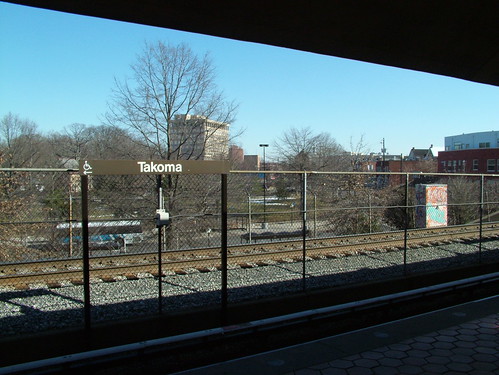
Right: Looking east from the Takoma Metro platform, with the 10 story former Adventist office building in the distance. Flickr photo by katmeresin.
2. It makes even less sense to promote automobility via the sale of WMATA land resources. According to the plans as submitted, most of the townhomes would have two-car garages.
Promoting automobility immediately on top of a WMATA subway station is short-sighted and seems to be a massive failure of vision. Transit-oriented development should promote transit. Development at transit sites that promotes automobile-based mobility is anachronistic, and seems counter to WMATA transit promotion objectives. In any case, such development can not be called "transit-oriented." At the very best, it should be termed "transit-adjacent development," but such is hardly beneficial to transit promotion.
3. CPC recommends that WMATA adopt a transit-first development policy generally, which should guide development plans for this and other similarly situated land parcels in the WMATA land inventory.
The City of San Francisco adopted a "transit first" development policy decades ago. For the most part this means that new development in the downtown core has been built without parking, but with access to efficient transit.
Moving to a "transit first" land use and development paradigm
Most citizens and government agencies are imprinted with an approach to land use that is automobile-centric and oriented towards segregated, relatively undense uses. This is commonly referred to as a suburban-oriented land use and development paradigm. Stakeholders have an unconscious and systematic bias towards "automobility" and improving the transportation system for automobiles, at the expense of transit and pedestrian capacity, and urban design.
The suburban land use approach is particularly inappropriate for center cities generally, and Washington specifically, especially because the city is so well connected by transit, in particular the subway, and relatively efficient bus service throughout most of the city, and because of the importance of leveraging the tremendous public investments that have been made in building and maintaining this system. (Note that the polycentric design of the WMATA subway system is criticized because it promotes sprawl even more than it improves access to and within the center city.)
A "transit-first" policy would establish and emphasize that the basic framework of how the City of Washington should grow is through the linkage-articulation of land use and transit. Intra-city and regional mobility can be improved and congestion reduced by investing in the capacity of our transit system, and by linking land use policies to these investments.
Furthermore, every parking space is an automobile trip generator. We cannot simultaneously expand parking and reduce congestion. The concept of induced demand presented both by parking spaces and roads is well understood throughout the transportation planning profession.
WMATA, as a transit agency, should not be in the business of promoting automobility, especially through its land development and disposition practices.
An illustration of how San Francisco's "transit first" development policies work in practice
According to the article "If you build it, will they take the bus? San Francisco builds an epic mall, with no parking," published in the Austin American-Statesman on Sunday, October 22, 2006, San Francisco's downtown growth management policy, adopted in 1985, for the most part, forbids the creation of parking spots when new development is constructed.
The article discusses the Westfield San Francisco Centre, which was just expanded, tripling the square footage to 1.5 million.
According to the article:
San Francisco's Westfield mall doesn't even have a parking lot. The nearest parking is across the street at a city-owned lot that also serves the Moscone convention center and other attractions. It can hold about 2,600 cars. Officials expect about 68,500 people a day on average, or about 25 million a year, will visit the mall. That works out to one parking spot for every 26 mall shoppers....
The mall also is in the middle of one of the biggest hubs for public transportation outside New York City. More than 30 different public transit sources are within a few blocks of the mall, including the Powell Street terminus of the city's famed cable car line, several stops for the Bay Area Rapid Transit subway system, and stops for municipal trains and buses.
4. A suggestion for how to apply a "transit first" policy to the Takoma Station development site: build a multiunit building with no parking whatsoever.
Many people suggest that choices be offered to house-buyers, yet true choices, especially a choice of not having to pay for a parking space, are rarely offered. Most new housing units come with parking. DC Zoning regulations provide for the most part (with some exceptions allowed for new housing constructed in historic districts) that at least one parking space be provided for every new unit of housing.
The concept of the location efficient mortgage, pioneered by the Center for Neighborhood Technology in Chicago, makes the point that households in close proximity to high-capacity and frequent transit are able to use transit rather than automobiles, thereby allowing more of the household revenue stream to be directed to housing costs, ideally towards ownership.
There are many people in the City of Washington who do not own cars. According to the most recent data from the U.S. Census American Community Survey, almost 40% of DC households do not own cars.
Why not provide a housing option for similarly-minded people--those who want to live in the city, who do not wish to own a car, who wish to live in proximity to convenient transit? The Takoma site offers access to the Red line subway, is one station stop north of a connection to the Green line, and is served by Metrobus and RideOn bus service. (It is also one stop from Silver Spring, which provides access to the MARC Commuter Railroad system, and is five stops from Union Station, with MARC, VRE, and Amtrak connections.)
Instead of building houses for cars with the townhome proposal, build more housing for people, by directing the construction of a multiunit, denser building, with more housing units overall.
This should provide more riders for both subway and bus service in the Takoma area, which might allow for an increased frequency of the bus services, given the generation of a greater number of riders.
The District Government's "stretch goal" of attracting 100,000 new residents is based on the fact that much of the city's property and a significant number of transactions in the city are not taxable because of the presence of the Federal Government and a wide variety of nonprofit tax-exempt organizations that have located in the city to leverage access to the Federal Government.
More housing will yield more residents to the District of Columbia, and therefore more property tax and income tax revenues, which comprise the greatest source of DC Government revenues.
Hence, a "transit first" policy with regard to the Takoma WMATA-owned development site would achieve multiple positive public policy outcomes.
5. One of the concerns expressed by Takoma area residents is that the construction of housing on the station site will reduce the number of parking spaces available to riders. Parking could be accommodated within a multiunit building but directed almost completely towards short-term and intermediate-term spaces for transit riders, as well as to visitors to the commercial districts of Takoma Park in Maryland and Takoma in DC. Visitors could park in this space and then make their way around on foot.
To accommodate occasional need for access to cars on the part of residents of the proposed multiunit housing alternative, some spaces could be allocated to carsharing services, and the building could negotiate priority membership privileges with these services. Otherwise, given the recommendations above, no parking spaces should be allocated to residents of the proposed multiunit building alternative suggested herein.
Note that many residents of the new multiunit housing constructed east and west of the Takoma Station do not own cars. Attraction of similarly minded new residents would be extended by the provision of new multiunit housing constructed without any residential parking (other than access to carsharing).
6. Open space concerns expressed by Takoma area residents should be acknowledged. A denser development, without parking, would allow for the retention of more open space.
7. However, urban design considerations would suggest that such space be reconfigured in part to allow for the strengthening of the streetwall and streetscape between the Station and Takoma Park, Maryland as represented by the relative activity vacuum created by the open space immediately abutting Carroll Avenue.
This could provide an additional revenue opportunity to WMATA, if instead of selling one parcel for a relatively insignificant amount of money by selling to EYA; that the parcel be split into two different segments: (a.) a site suitable for a multiunit single building of housing, likely on the parking lot; (b.) some amount of land immediately abutting Carroll Avenue.
8. The provision of quality bus service should be maintained. Although it is believed that this can be accommodated through better configuration of bays and management.
9. "Transit first" policies also promote pedestrian and bicycle mobility in addition to transit. CPC does not favor the proposed reduction of bicycle parking at the Takoma Station, which appears to be heavily used, perhaps at a level even greater than that of Union Station or College Park. Additionally, CPC suggests that opportunities be explored for providing additional exits off the platform, perhaps providing access to the west side of the railroad tracks (egress is provided solely on the east side currently).
Thank you for your consideration of these comments.
Respectfully submitted,
Labels: neighborhood revitalization, smart growth, transit oriented development, transportation planning, urban design/placemaking



8 Comments:
Excellent and thorough, as usual. I am so pleased to see the development next to the Brookland Metro station. It is a great addition to the neighborhood and I imagine that all but the most ardent antis will eventually come to accept it and perhaps even like it. It is certainly a HUGE improvement over the weedy vacant lots surrounded by chain link fence that it replaces. My wife just recently finished graduate school at Catholic and I have to admit I worried about her walking to the Metro after dark past those aforementioned vacant lots. By daylight, they were unsightly; at night they were downright scary. (By the way, how silly does that suburban style old Pizza Hut look now? I appreciate that it is a daycare center and that that use makes it difficult to critique, but architecturally, it is an abomination from the era when people mistakenly thought that the way to save cities was to make them look like suburbs.) As for the parking lots and grass on the east side of the Metro station, they are not much better. My friend who lives in Brookland aptly describes them as "green in color only." I agree that some open space should be preserved around the Brooks mansion, but otherwise, that parking lot and desultory patch of grass is the opposite of what Jane Jacobs preached. There are no eyes on the street there and the walk from the escalator across the parking lot to 10th Street is pretty scary after dark. Anyway, every time I ride my bike up the Metro Branch Trail and then on up to Takoma, I am pleased to see that those who think vacant lots and parking lots next to an in-city Metro station make sense are slowly and steadily losing.
It's gonna change a lot. I didn't know, but I was informed when I worked in Brookland as a Main Street program manager that the lot immediately next to the Metro had been a Holiday Inn which went into disrepair, the CUA bought the site, and tore down the building. Now it's being reborn as the building pictured at the start of the entry.
FWIW, I don't remember where, but I happened across a postcard, which I acquired, of the old Holiday Inn in Brookland, ...
FWIW/2, I outlined that development program at the first advisory committee meeting for the Brookland small area plan.
But the plan needed a direct cultural element, which is doesn't have. So the developers are doing their own thing, with consultants and such, and it is discoordinated.
Two things I suggested aren't happening. One is moving up Dance Place's performance space to the new Monroe Street spine. The other would be for CUA to move the Hartke Theater and other arts related programs over to the part of the campus immediately abutting the Metro Station.
It would be better if it were on Michigan Ave., but they could put it in the parking lot of the power plant, or they could put it where Pangborn is and move the functions in that building...
P.S. that statement submitted on the EYA dev. back in 2006 is probably my strongest statement on transit first. It's the first foray. Then I further developed it in a blog entry and then a paper I wrote for a class in 2007.
http://urbanplacesandspaces.blogspot.com/2007/02/not-being-able-to-build-your-way-out-of.html
And the People's Transpo. Plan in 2008.
http://urbanplacesandspaces.blogspot.com/2008/02/revised-peoples-transportation-plan2008.html
I wasn't around during the freeway fights of the 1960s, but I get the sense then that the community opposition was rather universal. There are some vocal antis surrounding the Monroe St. Market and Colonel Brooks development, and they'll get louder when the "Brookland Green" development starts to become a reality. On the other hand, there are lots of new families, intent on settling and staying, who are in favor of the new developments. Even some of the 20 year residents, while perhaps a bit careful when talking to their neighbors, are solidly in favor.
A very apt quote, from the blogger Timothy Burke (of the Easily Distracted blog):
I was frustrated as a student activist in the 1980s about our dependency on the narratives and grammar of activism that we inherited from the 1960s and 1970s. Sometimes it felt more like we were historical re-enactors than people living our own lives, making our own struggles. What they had done seemed so much more heroic and consequential, against a seemingly clearer moral canvas, that the temptation to collapse the decade and a half in-between was often too hard to resist.
... hmm, wrt to my experience in the 1980s with activism, I thought there was a reflexive more narcissistic activist orientation, based on a response to the 60s activists (and the 60s really ended in 1975 with the US leaving Vietnam) and the belief in the so-called "failure" of 60s activists and a need to do something different. (Few people had read Gitlin's _The Whole World is Watching_.)
They succeeded at some things, but not others. The same goes with the 1980s activists, who in Ann Arbor at least, were focused on US involvement in Central AMerica, and the disinvestment of university investments in corporations with South Africa presence. (Dean Baker, co-director of the Economic Policy Institute now, was one of those activists...) We had some impact, and some failures. I learned a lot though.
Anyway, it's important to learn the real lessons, which we do too infrequently.
"Anyway, it's important to learn the real lessons, which we do too infrequently."
And what, pray tell, are the "real" lessons?
-EE
why you win and why you don't. The brookland lesson to them is that they can fight off any development.
The real lesson is that they can fight off bad development, not any development.
Thanks so much for the site, I found a lot of useful information for us.
Post a Comment
<< Home